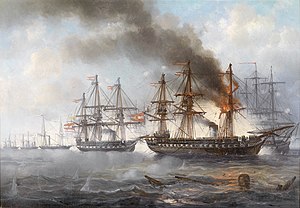
Back Bitva u Helgolandu Czech Søtræfningen ved Helgoland Danish Seegefecht bei Helgoland (1864) German Batalla de Heligoland (1864) Spanish Helgolandin meritaistelu (1864) Finnish Bataille de Heligoland (1864) French Siaslacht bi Haliglun (1864) FRR קרב הלגולנד (1864) HE Battaglia di Helgoland (1864) Italian ヘルゴラント海戦 Japanese
| Battle of Heligoland | |||||||
|---|---|---|---|---|---|---|---|
| Part of the Second Schleswig War | |||||||
 The Battle of Heligoland by Josef Carl Berthold Püttner | |||||||
| |||||||
| Belligerents | |||||||
|
|
| ||||||
| Commanders and leaders | |||||||
|
|
| ||||||
| Strength | |||||||
|
2 screw frigates 1 screw corvette |
2 screw frigates 1 aviso 2 gunboats | ||||||
| Casualties and losses | |||||||
|
14 killed 54 wounded 1 frigate damaged |
36 killed 108 wounded 2 frigates damaged | ||||||
The Battle of Heligoland (or Helgoland) was fought on 9 May 1864, during the Second Schleswig War, between a Danish squadron led by Commodore Edouard Suenson and a joint Austro-Prussian squadron commanded by the Austrian Commodore Wilhelm von Tegetthoff. The action came about as a result of the Danish blockade of German ports in the North Sea; the Austrians had sent two steam frigates, SMS Schwarzenberg and Radetzky, to reinforce the small Prussian Navy to help break the blockade. After arriving in the North Sea, Tegetthoff joined a Prussian aviso and a pair of gunboats. To oppose him, Suenson had available the steam frigates Niels Juel and Jylland and the corvette Hejmdal.
On the morning of 9 May, the two squadrons encountered each other off the island of Heligoland, then controlled by neutral Great Britain. Tegetthoff attacked with his two frigates while the slower Prussian vessels lagged behind, unable to effectively engage the Danish warships. Tegetthoff's flagship, Schwarzenberg, bore the brunt of the Danish gunfire and caught fire three times, the last of which could not be put out quickly and forced Tegetthoff to seek shelter in the neutral waters around Heligoland. Though Denmark claimed a tactical victory in the battle, the Danes were forced to end the blockade of the German coast. An armistice came into effect three days after the Battle of Heligoland. By the time fighting broke out again in June, further Austrian warships had arrived to strengthen the Austro-Prussian naval forces, and the Danes did not seek to challenge them.
Historians' opinions on the outcome of the battle are mixed, with some citing the withdrawal of Tegetthoff's ships, and the greater damage they sustained, as evidence of a tactical victory for Suenson. Other naval historians cite the lifting of the blockade as a strategic victory for the Austrians and Prussians, and others still describe the battle as inconclusive. The Battle of Heligoland was the last naval battle fought by squadrons of wooden ships, and it was also the last time Danish warships fought a major action. Jylland is preserved in Ebeltoft, the last surviving wooden-hulled, screw-driven warship.